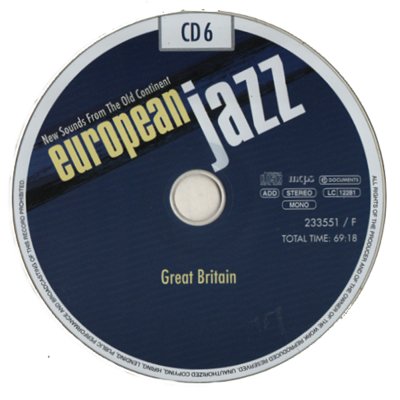 At one time, the concept of “European Jazz” meant very little indeed. While jazz was developing in the USA in the 1920s, there was almost no European jazz to speak of. Some Americans – Benny Carter, Coleman Hawkins, Sidney Bechet – came to Europe and made an impact there in the 1930s but it was not until the thirties that Europeans began to develop their own jazz significantly. Perhaps the most outstanding group was the Quintet of the Hot Club of France, formed in 1934, with its two virtuosos Django Reinhardt and Stéphane Grappelli.
At one time, the concept of “European Jazz” meant very little indeed. While jazz was developing in the USA in the 1920s, there was almost no European jazz to speak of. Some Americans – Benny Carter, Coleman Hawkins, Sidney Bechet – came to Europe and made an impact there in the 1930s but it was not until the thirties that Europeans began to develop their own jazz significantly. Perhaps the most outstanding group was the Quintet of the Hot Club of France, formed in 1934, with its two virtuosos Django Reinhardt and Stéphane Grappelli.
This group is not represented in this ten-CD boxed set, which suggests that the compilation is making no attempt at a historical survey. Indeed, it is difficult to know what this set is trying to do. It seems as if the compilers simply put together tracks to which they had access, and there is little attempt to provide a balanced view of European jazz. Nevertheless, this collection can be educative in opening our ears to some artists we may not have heard before. It also supplies a cross-section (albeit limited) of how Europeans developed jazz, mostly in the 1950s and 1960s.
This compilation makes it clear that European jazz was very much influenced by the Americans. For example, the tenorist on track 2 of the third CD sounds very like Stan Getz, while the altoist on the third track betrays the influence of Charlie Parker. And the Michael Naura Quintet on the eighth CD could be mistaken for the Modern Jazz Quartet.

I can’t tell you who most of the individual musicians are, as detailed personnels are sadly not given. This is a nuisance, as I would like to be able to identify (for instance) the bongo Brandenburgplayer on track 9 of the fifth CD. However, one lesson of many tracks in this collection is that many Europeans learnt from the bebop pioneers – and from such groups as the Gerry Mulligan Quartet. As most of the tracks in this compilation come from the fifties and sixties, there is little individuality in the music from the different countries, as it was only later that they began to develop their own distinctive styles.
The next two albums are devoted to Great Britain. They include examples by two neglected tenorists: Wilton “Bogey” Gaynair and Joe Harriott, both with Jamaican origins. Tubby Hayes and the Jazz Couriers deliver their usual hundred-notes-a-minute, while Johnny Dankworth’s orchestra plays some tight arrangements. (musicweb-international.com)

No, no, no … this compilation is not so weak, as we read above … it´s a great compilation with lots of rarities from the young European Jazz-Scene during the 50´and this time we hear great Jazz from Great Britain ! Excellent stuff !

Tracklist:
Tubby Hayes and the Jazz Couriers feat. Ronnie Scott:
01. Royal Ascot (Hayes) 5.33
02. On A Misty Night (Dameron) 5.09
03. Cheek To Cheek (Berlin) 4.07
Johnny Dankworth & His Orchestra:
04. Treasure Drive (Dankworth) 2.44
05. Riverside Stomp (Dankworth) 3.32
06. After The Party (Dankworth) 3.34
The Dizzy Reece Quartet:
07. Main Title from “Nowhere To Go“ (Reece) 3.30
08. The Escape And The Chase (Reece) 2.46
09. The Search (On The Scene) (Reece) 3.28
10. Sunset Scene (Nowhere To Go) (Reece) 1.28
Victor Feldman Modern Jazz Quintet – Septet:
11. Umf (Reece) 7.41
12. Bird‘s Last Flight (Gray) 6.32
The Joe Harriott Quintet:
13. Straight Lines (Harriott) 5.55
14. Caravan (Ellington/Tizol) 5.31
Lennie Felix:
15. Scene 59, Act 2 (Felix) 5.07
Vic Ash Sextet feat. Johhny Scott:
16. Just For The Boys (Scott) 2.59
Melody Maker Poll Winners (feat. Tubby Hayes, Ronnie Ross, Bill Le Sage):
17. Hark Dog (Moule) 5.12

More from the “European Jazz” edition:


 At one time, the concept of “European Jazz” meant very little indeed. While jazz was developing in the USA in the 1920s, there was almost no European jazz to speak of. Some Americans – Benny Carter, Coleman Hawkins, Sidney Bechet – came to Europe and made an impact there in the 1930s but it was not until the thirties that Europeans began to develop their own jazz significantly. Perhaps the most outstanding group was the Quintet of the Hot Club of France, formed in 1934, with its two virtuosos Django Reinhardt and Stéphane Grappelli.
At one time, the concept of “European Jazz” meant very little indeed. While jazz was developing in the USA in the 1920s, there was almost no European jazz to speak of. Some Americans – Benny Carter, Coleman Hawkins, Sidney Bechet – came to Europe and made an impact there in the 1930s but it was not until the thirties that Europeans began to develop their own jazz significantly. Perhaps the most outstanding group was the Quintet of the Hot Club of France, formed in 1934, with its two virtuosos Django Reinhardt and Stéphane Grappelli.



